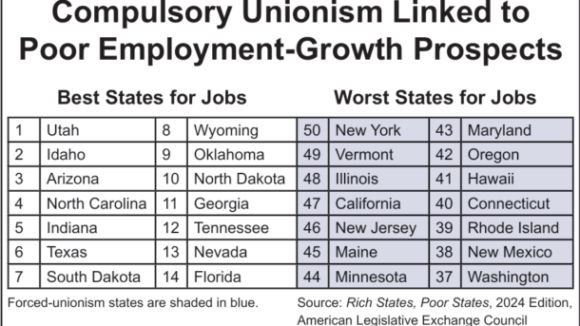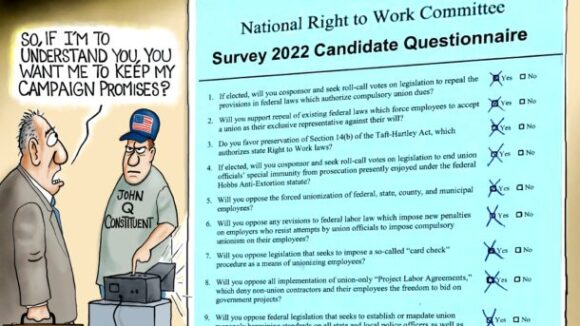Is This Any Way to Run a City’s Schools?
Leaked CTU Proposals Won’t Do Anything to Improve Schools’ Poor Performance
Protecting the Right to Work Improves Overall Job Climate
Early this year, Chief Executive magazine asked 651 CEOs from around the country to grade all 50 states and the District of Columbia in three general categories that businesses invariably consider when they are contemplating where to make job-creating investments.
As Chief Executive’s editors note, the business leaders were asked to “draw upon their direct experience” to rate each state for a) taxation and regulation, (b) quality of workforce, and (c) living environment.
In its May/June issue, Chief Executive published the survey results. They indicate that, in the wake of the severe 2008-2009 recession, state Right to Work laws may be even more critical for private-sector job and income growth than they were in the generally favorable national economic climate of 1982-2007.
Overwhelmingly, the CEOs judged that, in Right to Work states, employees have superior work ethics, real estate costs are relatively low, and public officials have a much more positive attitude toward business.
Every one of the seven states with the highest overall rankings has a Right to Work law prohibiting the firing of employees for refusal to pay dues or fees to an unwanted union. Nine of the top 10 states are Right to Work states. Thirteen of the top 15 are Right to Work states.
In contrast, forced-unionism states dominated the bottom ranks of the 2010 survey. Not one of the bottom 10 states has a Right to Work law on the books. In 14 of the 15 bottom-ranking states (including the District of Columbia, counted as a “state” for the purposes of the survey), employees may legally be forced to pay union dues as a condition of employment.
Long-Term Economic Data Confirm Accuracy of Business Leaders’ Judgment
Long-term economic trends as documented by the U.S. Labor and Commerce Departments confirm that business leaders’ judgment in giving kudos to Right to Work states and “raspberries” to forced-unionism states is spot on.
For example, Labor Department data show that, from 1999 through 2009, private-sector employment nationwide was virtually flat, declining by 0.3%, or 370,000 jobs.
However, Right to Work Florida, Georgia, Nevada, North Carolina, Tennessee, Texas and Virginia, the top seven states according to Chief Executive’s 2010 survey, experienced an overall private-sector job increase of 4.6%, or 1.186 million jobs.
Meanwhile, forced-unionism California, Connecticut, Illinois, Massachusetts, Michigan, New Jersey, and New York, Chief Executive’s bottom seven states, suffered an aggregate private-sector job loss of 3.9%, or 1.386 million jobs.
The Commerce Department’s annual personal income data, adjusted for inflation with the help of the Labor Department’s Consumer Price Index, show an even starker contrast in economic growth between Chief Executive’s high-ranking Right to Work states and its low-ranking forced-unionism states.
Right to Work Laws Linked To Higher Real Incomes
From 1999 to 2009, real personal income nationwide grew by 18.1%.
However, in the seven Right to Work states at the top of Chief Executive’s 2010 rankings, aggregate real personal income grew by 25.7%, or nearly half again as fast, and nearly double the growth rate of the seven forced-unionism states at the bottom of Chief Executive’s list.
In addition to enjoying far faster job and income growth, Right to Work states benefit from generally lower costs and higher real incomes than forced-unionism states.
For example, the seven Right to Work states rating highest in Chief Executive had an average 2009 cost of living 22% lower than the seven bottom-ranking forced-unionism states, according to housing, food, energy, and other price data compiled by the nonpartisan Missouri Economic Research and Information Center.
The average cost of living-adjusted 2009 disposable income per capita for the seven Right to Work states was $35,630, more than $3000 higher than the $32,555 average for the seven forced-unionism states.
“It shouldn’t come as any surprise that forced-unionism states as a group, and not just the seven found by Chief Executive to be the worst of all, are lagging behind Right to Work states by all the most significant economic measures,” said National Right to Work Committee President Mark Mix.
“Big Labor’s counterproductive work rules and fomentation of the ‘hate-the-boss’ mentality lead to slower revenue growth in the unionized businesses themselves.
“That translates into smaller compensation increases for employees and less employment growth or, very frequently, employment losses.
“On top of that, union bosses funnel a huge chunk of the forced dues and fees they collect with federal labor law’s abetment into efforts to elect and reelect state and local, as well as federal, Big Labor politicians who support higher taxes and more red-tape regulation of business.”
Forced-Unionism States’ Disadvantage Likely to Widen in the Future
“The actions of forced-dues funded politicians thus result in less income and job growth, period,” Mr. Mix concluded.
“And, unless union monopolists’ grip over states like California, which received Chief Executive’s booby prize for the second year in a row, can somehow be loosened, their disadvantage is likely to widen in the future.
“Today, Californians fork over a higher share of their incomes in state and local taxes than residents of all but five other states, but still face unfunded public-employee pension liabilities of as much as $500 billion.
“Meanwhile, overall income growth in the once-Golden State has fallen well below the national average in recent years.
“But forced dues-collecting government union officials, who wield monopoly-bargaining control over nearly 60% of California’s public employees, compared to 41% nationwide, are fine with the status quo.
“And they are furiously opposed to all substantive proposals to stop taxpayers’ government compensation costs from spiraling out of control.”
Many States Still Have a Chance to Avoid Becoming ‘Another California’
On a happier note, Mr. Mix added that many of the other 27 forced-unionism states may still avoid becoming “another California” by passing Right to Work legislation within the next few years.
“In this year’s elections,” he explained, “freedom-loving citizens in states like New Hampshire, Kentucky, Indiana, Ohio, Colorado, Montana, and New Mexico are turning up the pressure on their state legislative and, in some cases, executive candidates to support enactment of state Right to Work laws.
“In multiple state candidate Survey 2010 programs, the National Right to Work Committee and allied regional and state organizations are mobilizing millions of citizens to contact their politicians regarding their compulsory-unionism records.
“Employees and business owners who are determined to see their state avoid California’s predicament may make politicians who refuse to support Right to Work pay a steep price.
“But there’s still time for many politicians who up to now have been Right to Work opponents to make amends with freedom-loving citizens by pledging publicly to oppose forced unionism 100% of the time in the future.”
“State politicians who are running for election or reelection this year can accomplish this objective by completing, signing and returning their Right to Work candidate surveys.”

Leaked CTU Proposals Won’t Do Anything to Improve Schools’ Poor Performance

Wherever Big Labor wields the power to collect forced union dues, union bosses funnel a large share of the confiscated money into efforts to elect and reelect business-bashing politicians. Employment growth tends to lag as a consequence.

Members Insist They Keep Pro-Right to Work Campaign Promises